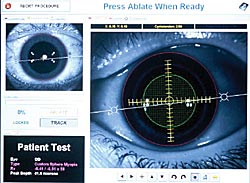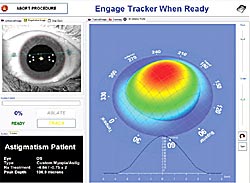Accuracy, speed of customized treatment enhanced with new laser system design
One of the first surgeons to use the new LADAR 6000 says the system provides good results with increased efficiency and improved ergonomics.
![Francesco Carones, MD [photo]](/~/media/images/news/print/ocular-surgery-news-europe-asia-edition/2005/12_december/carones_70_90_6272.jpg) Francesco Carones |
The results of our first patients treated with the Alcon LADAR 6000 confirm my expectation of achieving outcomes as good as those from the LADARVision 4000. The system’s new design, however, makes achieving those results much easier.
In a pilot study that compared customized treatment with the LADAR 6000 to conventional treatment, we found that the majority of custom-treated eyes achieved an uncorrected visual acuity that was better than or equal to their preoperative best corrected visual acuity.
Pilot study
The 52 eyes in the study were not randomized between the custom LADAR 6000 group and the conventional treatment group. Instead, we dedicated the custom treatment to those patients who needed the most treatment – those who had the most sphere. We wanted to avoid inducing additional aberrations in those patients, which could have occurred if we provided conventional treatment.
In the study, 24 eyes had CustomCornea treatment, and 28 had conventional treatment. Uncorrected visual acuity at the 1-month follow-up was slightly better for the conventional treatment group, but that was because intended correction in this group was lower with less astigmatism. Overall, the results were good, with all eyes in the series achieving 20/25 or better uncorrected vision postoperatively.
With respect to accuracy of treatment, 1-month follow-up showed that the CustomCornea-treated eyes were closer to intended correction than were the conventional eyes even though intended correction was higher in the CustomCornea group. The accuracy is intended to be better when doing custom rather than conventional treatment, and this is why I do custom treatments in all the cases I can.
The average spherical equivalent was stable between 1 week and 1 month postop, and we categorized the root mean square as an extremely successful outcome in all eyes. There was no loss of Snellen lines, except for one conventional eye that went from 20/12 to 20/16, which is a clinically insignificant loss.
These results, which represent the first evaluation of the LADAR 6000, indicate that the new system achieves results that are equivalent to LADARVision 4000. My experience using this system indicates that it achieves these results with greater comfort and ease for both the patient and surgeon.
Thanks to the features of the new system, the transition would be seamless for any practice currently using the system and much easier for those who would like to try it for the first time.
 |  |
Diagnostic information from the LADARWave can be transferred to the laser. Right: Software prompts simplify the new system. Images: Carones F | |
Expectations
As one of the first surgeons to have access to the new laser system, I thought it prudent to define my expectations prior to treating patients so that I could perform an objective evaluation. Having gotten effective and consistent results with the LADAR Vision 4000 for several years, I expected the new system to provide the same results, but with some improvements to the operation of the system and to control over the surgery.
What I found was overall system improvement resulting in reduced procedure time, improved procedure consistency and enhanced visualization. The new system is capable of a faster repetition rate of 100 Hz, which is double that of the LADARVision 4000, resulting in all procedures being completed in less than 1 minute and most taking less than 40 seconds. This, along with the addition of automatic registration, combines to speed patient flow significantly.
Our procedure benefits from a combination of speed, automation and control to improve the quality of vision we can offer our patients. Thanks to approval of the expanded range of correction, the system can treat +1 D to –9 D of spherical equivalent as well as astigmatism up to 6 D internationally.
Ergonomics, efficiency
Additionally, the newly designed ergonomics are more user friendly for both the patient and surgeon and facilitate easier patient flow through the surgery. The new platform uses automation to bring a more relaxed, controlled and efficient laser refractive experience to the surgeon. An important part of this is the improved ergonomics of the console and laser. The console is easier to fit into the operating room, and a new articulated arm can be positioned for better visualization of the monitor screen.
Improved illumination via a ring light array simplifies patient fixation. Off-axis lights improve working distance and make observation of the flap and the bed much crisper and easier than the LADARVision 4000, and software prompts accompany the surgeon through procedure, resulting in increased consistency.
I found one of the most significant changes to be a new gas cavity, which allows for more gas efficiency and less gas use. This makes it possible to change the gas once a week instead of once a day, and to replace the gas once every 6 months rather than once a month.
For Your Information:
- Francesco Carones, MD, is the co-founder and medical director of the Carones Ophthalmology Center in Milan, Italy. He can be reached at Via Pietro Mascagni, 20, 20122 Milano, Italy; +39-02-7631-8174; e-mail: fcarones@carones.com; Web site: www.carones.com. Dr. Carones is a consultant to Alcon Laboratories.
- Alcon Laboratories, maker of the LADAR 6000, can be reached at 6201 South Freeway, Fort Worth, TX 76134 U.S.A.; +1-817-293-0450; Web site: www.alconlabs.com.
